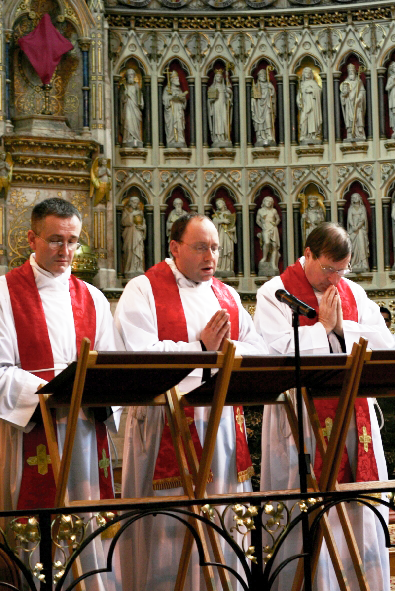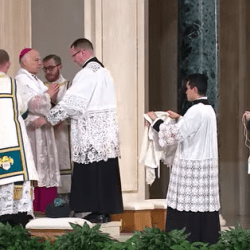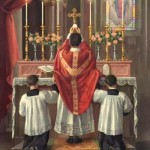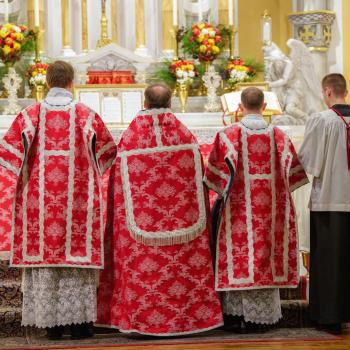After reading the post about Elizabeth Scalia’s forgettable Palm Sunday, a couple folks on Facebook noted that, in fact, the congregation (voicing the “crowd”) isn’t really supposed to be involved in this gospel reading. Similarly, the voice of Christ should only belong to the priest (unless, for some reason, that’s just impossible.)
I was surprised to learn that. I went scurrying to find information.
I uncovered this, from the Congregation for Divine Worship:
33. The passion narrative occupies a special place. It should be sung or read in the traditional way, that is, by three persons who take the parts of Christ, the narrator and the people. The passion is proclaimed by deacons or priests, or by lay readers. In the latter case, the part of Christ should be reserved to the priest. (Emphasis added.)
The proclamation of the passion should be without candles and incense, the greeting and the signs of the cross are omitted; only a deacon asks for the blessing, as he does before the Gospel.[37]
For the spiritual good of the faithful the passion should be proclaimed in its entirety, and the readings which precede it should not be omitted.
34. After the passion has been proclaimed, a homily is to be given.
Later, the document says the same rubric is to be followed on Good Friday.
A 1999 letter by the USCCB, meantime, raised concerns about how the Passion is proclaimed:
The Newsletter of the US Bishops’ Committee on the Liturgy, Jan.-Feb. 1999, comments on the presentation of the Passion in parts, and makes this point:
While it has a dramatic quality, the Passion is not so much a drama enacted as a narrative proclaimed solemnly and simply, without candles, incense, greeting, or signs of the cross. (Original emphasis.)
The article urges that “careful consideration should be given to the effect which this practice may have” — does reading in parts mean that everyone in the congregation is watching the “script”? Does it “allow each individual to meditate effectively on the word proclaimed?” (Thirty-Five Years of the BCL Newsletter, USCCB, 2004, pp 1625-26.)
While nothing here prohibits people in the pews from taking over the “crowd” part in the reading, it doesn’t endorse it, either. And the Vatican instruction seems clear about how it’s supposed to be done.
The USCCB, meantime, does offer these guidelines, for other Sundays in Lent:
Reading the Gospel in parts (by several readers) is restricted to the reading of the Passion of the Lord on Palm Sunday and Good Friday, and is not permitted on Sundays during Lent. This is made clear in the GIRM, paragraph 109:
109. If there are several persons present who are able to exercise the same ministry, nothing forbids their distributing among themselves and performing different parts of the same ministry or duty. For example, one deacon may be assigned to take the sung parts, another to serve at the altar; if there are several readings, it is well to distribute them among a number of lectors. The same applies for the other ministries. But it is not at all appropriate that several persons divide a single element of the celebration among themselves, e.g., that the same reading be proclaimed by two lectors, one after the other, except as far as the Passion of the Lord is concerned. (Emphasis added.)
This is emphasized also in the 2002 commentary, “The Theological Vision of Sacrosanctum Concilium and the Roman Missal” (Liturgy of the Word – How is this enfleshed in the GIRM), also on the USCCB web site,which says:
The division of any readings into parts, except for the Passion, is prohibited by the new Instruction [ref GIRM] (109).
So now you know.
For as long as I can remember, wherever I’ve marked Good Friday or Palm Sunday, it’s always been done with the congregation joining in as the crowd.
Good luck getting your parish to change this.












